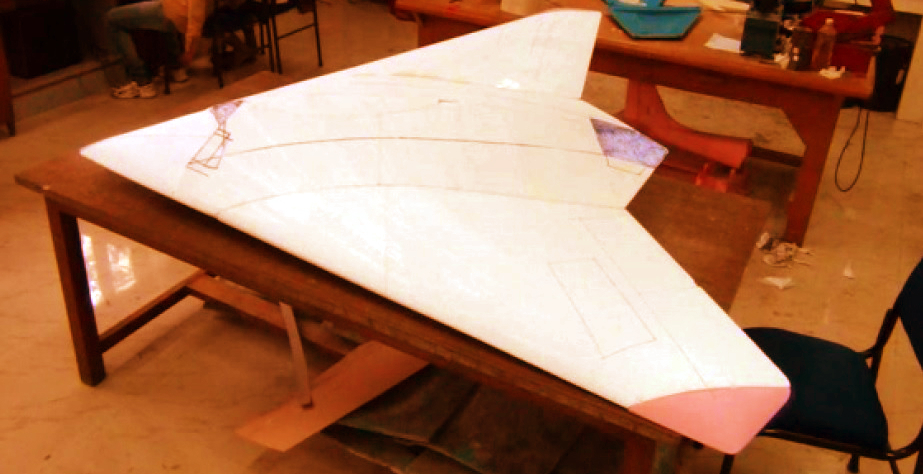
PART 1 OF THE INDIAN FUTURE WEAPONS SERIES
At one end of a sparsely lit chamber is a cluster of row desks with computer terminals. Most of the computer screens are off, tiny orange lights indicating they’re only hibernating in ‘power save’ mode. At least one terminal has a student in jeans slouched in front of it, two bottles of mineral water at his feet. It’s late, well after work hours. Not unusual for a college laboratory. Except, there’s nothing about this room that’s even remotely run-of-the-mill. A mess of wires disappears mysteriously into another room, darkened at this time of night. It is in a cleared out space behind the lone student working past midnight that the room’s chief occupant sits on a long brown table.
Coloured white and shaped tantalizingly like an arrow head is a rough aircraft model, quite clearly in the middle of a fabrication process. Parts of the model appear tacked together with tape. Students building aero-models is far from uncommon, especially at India’s most prestigious engineering school, but this white craft has more riding on it than anything the Indian Institute of Technology, Kanpur’s (IIT-K) famed aeronautical department has ever been entrusted with before. Within the six-foot frame of the model that sits on this table, and an identical metallic clone in a chamber a few hundred meters away, lies the future of India’s combat air power.
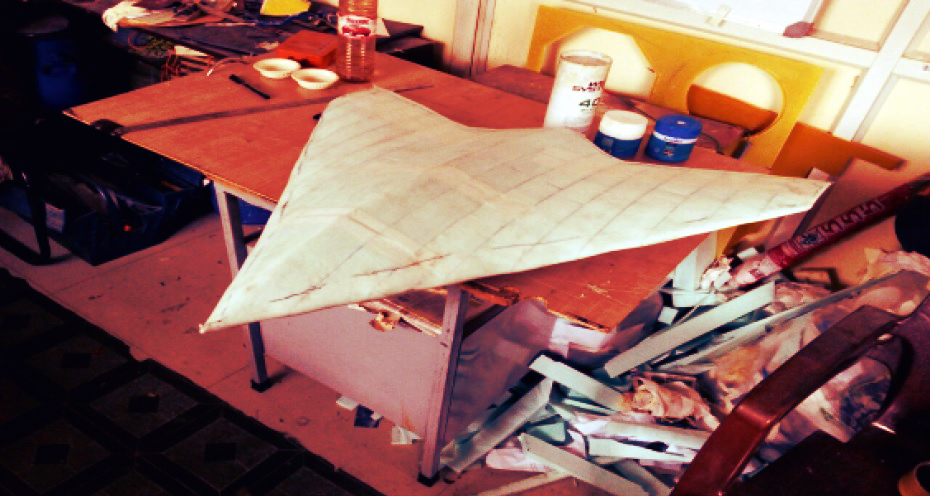
Codenamed SWiFT, short for stealth wing flying testbed, the aircraft is a technology demonstrator being designed and built in collaboration with the Aeronautical Development Establishment (ADE), a government military laboratory in Bengaluru. While the white model is used as a shaping test platform, the black fabricated metal clone of the SWiFT undergoes wind tunnel testing at IIT-K’s in-house facility. And no, these models aren’t just for show.
Top sources associated with the project have confirmed to Livefist that by the end of this year, a prototype SWiFT will be fitted with a Russian NPO Saturn 36MT turbofan engine (which currently powers the Nirbhay cruise missile) and launched on its first flight during the 2018-19 financial year. It will be the first major step in India’s effort to wield an stealthy unmanned aircraft built to fire precision weapons at designated targets in unfriendly airspace.
In the broadest sense, the Ghatak is intended to be an aircraft launched covertly near or over hostile territory, evading enemy sensors by virtue of its stealth, and destroying identified targets with air-to-ground weapons. In a broader sense, such stealth could also be used to gather electronic intelligence or covertly conduct airborne surveillance. Primarily though, the Ghatak is simply being developed as an unmanned bomber (A temporary working title even identified it as the Indian Unmanned Strike Air Vehicle or IUSAV).
In every conceivable sense, the SWiFT getting airborne will constitute a flight into the unknown — for the research team leading the effort at IIT-K, the clutch of government military laboratories under the Defence R&D Organisation (DRDO) that ‘handle’ the project, and not least, the Indian Air Force that will be its primary operator.
“The project is fully positioned as a futurustic platform. It draws very little from any existing technologies in the country,” an IIT-K student associated with the project told Livefist. “Everything we’re doing here is fundamental. And that is why it is so important.”
The research project at IIT-K is to receive at least $8 million towards proving the contours of the SWiFT. But this little aircraft being finetuned and tested by the aeronautical research task force at IIT-K, is essentially a miniaturised model of something much larger. When it enters flight testing before March next year, the SWiFT will begin proving technologies and parameters for an unmanned weaponised aircraft approximately eight times its size. The big final unmanned combat aircraft (UCAV) named Ghatak has a seven-year deadline to lift off. This holy grail of the entire effort is being spearheaded in Bengaluru by the Aeronautical Development Agency (ADA), a consortium of government labs and agencies devoted to combat aircraft.
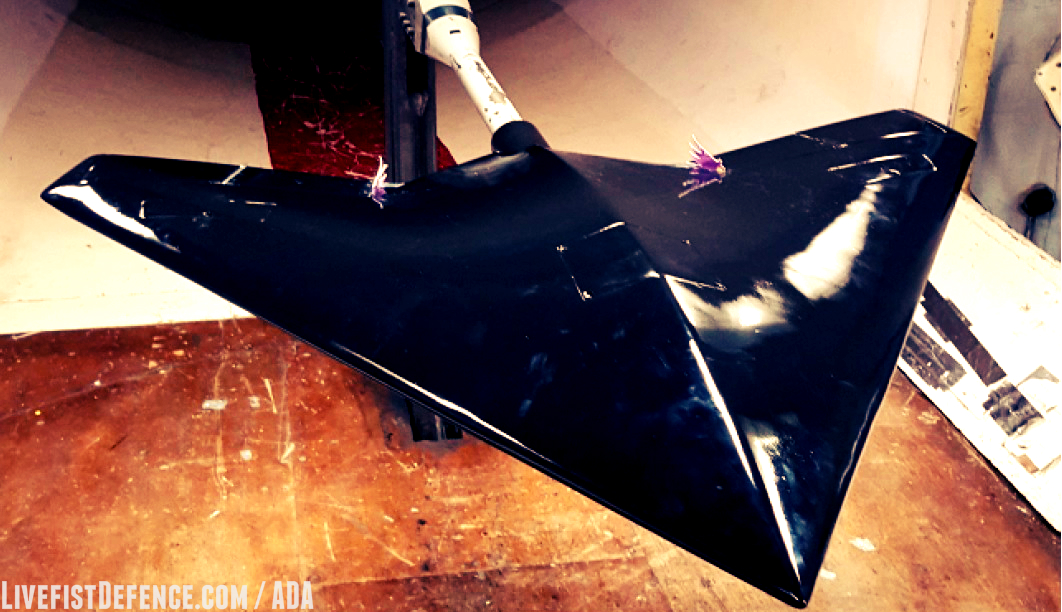
The Ghatak began as Project AURA (autonomous unmanned research aircraft), a program revealed first on this site in 2010. Classified and administered by a team of high level experts that reports directly to the Prime Minister’s Office, it is easily the most significant current military aviation thrust anywhere in the country. The expert committee that oversees the Ghatak program is headed by Dr. R Chidambaram (Principal Scientific Advisor to the government), with former DRDO chief & current member of the Niti Aayog Dr. V K Saraswat and former ISRO chief Dr. K Radhakrishnan. Their report to the PMO in 2016 has been a blanket endorsement of the program, urging the government to support it in every way. An ‘in principle’ approval of the program is likely to yield full-fledged project status in the 2018-19 financial year.
In an exclusive interview to Livefist, DRDO chief Dr. S. Christopher made his first ever comments on the Ghatak and SWiFT programs.
“Nobody will share the technologies that go into Ghatak. And that’s the reason why we have committed to building every piece of technology that will make this a proven stealth unmanned combat aircraft,” Christopher told your correspondent in a phone interview from Bengaluru, where has just met with the project leadership. “Whatever beating we have got so far will be nullified. The day when technologies are denied, I can say I have my own.”
The ‘beating‘ Dr. Christopher refers to is two-fold. One, the steady stream of media and public criticism the DRDO has persistently come under for cost and time overruns on many of its projects, including the LCA Tejas light fighter. And two, the opportunistic technology denial regimes that have bedeviled several Indian homegrown military projects. The DRDO chief’s chagrin is based on the perceived hypocrisy of countries and governments that readily offer their aircraft and weapons for sale to India, but step back when it comes to sharing useful technologies for India’s indigenous weapons programs. India’s lucrative arms requirements have recently compelled countries to ‘sweeten’ arms packages with offers of high-end technology for projects like the Ghatak, though the government has decided that the stealth UCAV needs to be as Indian as possible — certainly all critical technologies.
While the SWiFT gets set for a first flight in a year, the bigger Ghatak is still a way off, with a first flight near impossible before 2024-25. As the IIT-K team works to finetune the SWiFT/Ghatak’s shape and contours — crucial to its stealth — the DRDO and ADA are working to do two things as quickly as possible: one, understand the study of radar signatures of such an aircraft, a science totally new to Indian aerospace scientists. And two, as crucial, finalise the jet engine that will power the Ghatak in its ultimate configuration.
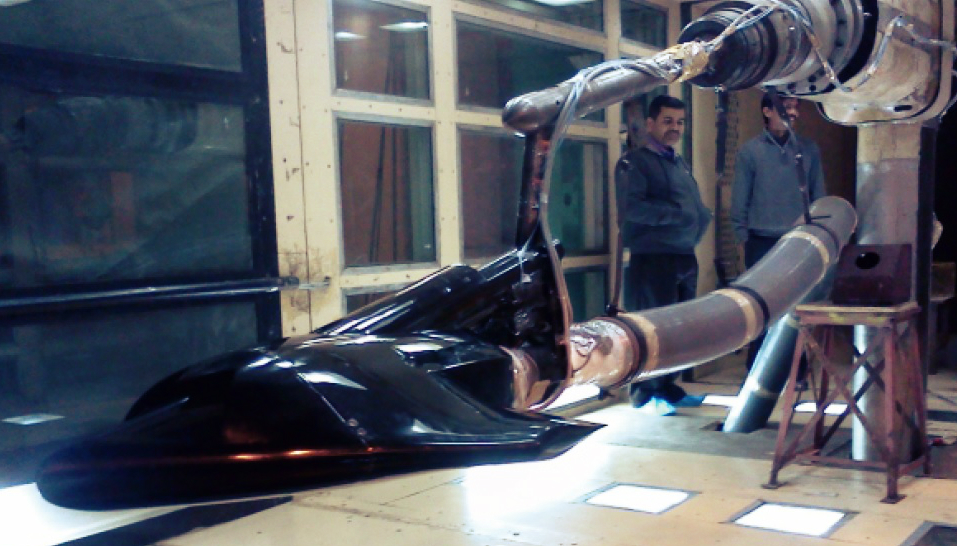
Dr. Christopher has officially confirmed an exclusive Livefist report from a year ago, revealing plans underway to build a full scale model of the Ghatak for radar signature and electromagnetic signature testing at a facility in Hyderabad.
“We are in the process of making the 1:1 model so that we can prove our RCS reduction capability via shaping and materials. We’ve got five labs working on the material side, while the airframe is completed by ADA. And that is what we are physically making because shape is most important. Shaping is 70 per cent of the signature reduction process. We’ve got an Outdoor Radar Cross Section Test Measurement facility (ORANGE) in Hyderabad which will test the model,” Dr. Christopher said.
The Ghatak project is proceeding on what can only be described as a shoe-string budget for the moment. Finances began to flow into the project in 2016 through a ‘lead-in’ project sanction for “design of GHATAK and Development of Critical Advanced Technologies for GHATAK” valued at Rs 231 crore (about $37 million). More significant expenditure will ensue once the SWiFT/Ghatak move forward. Crucial to progress is choosing an engine for the Ghatak. As noted above, the SWiFT technology demonstrator will fly with a Russian mini-turbofan. The bigger Ghatak will need far more growl. And as Livefist reported, power will almost definitely be drawn from a variant of the indigenous Kaveri jet engine.
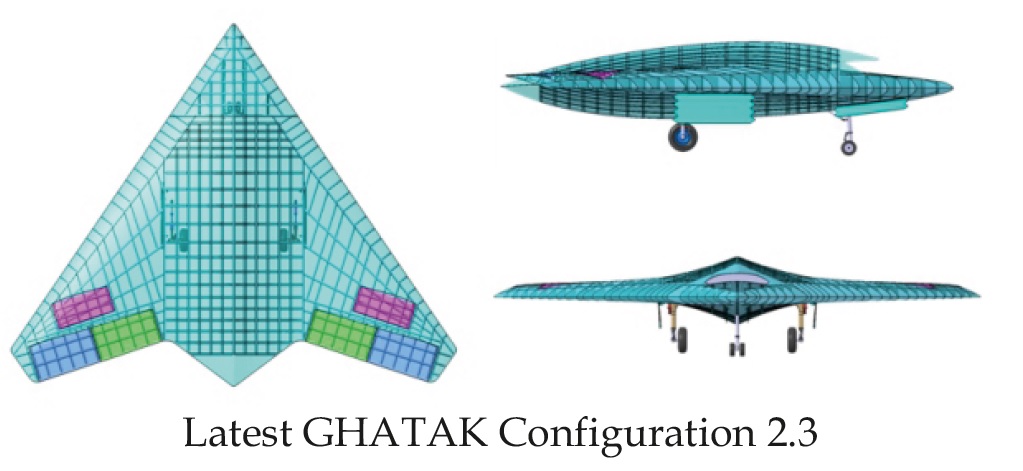
The Kaveri, developed originally for the LCA Tejas fighter project, has fallen famously short of expectations. However, a partnership with France’s SAFRAN as part of offsets from India’s multi-billion dollar deal for 36 Rafale fighters (Rafales are powered by Safran engines) has set down the modalities for a rescue mission that will save the Kaveri from oblivion, and dust it up for improved performance.
“We are almost at a final understanding with the IAF that we will use the Kaveri dry engine (i.e. non-afterburning). In the Kaveri that we have, we weren’t getting the power that we wanted. It started out with started with 80 kN and then 90 then 98 kNs. In a dry version for Ghatak, even 50 kN will be more than sufficient. We will be finalising that very shortly,” Dr. Christopher said.
In its 2015-16 annual report, the Aeronautical Development Agency (ADA), a consortium of agencies leading the development of, among other things, India’s Light Combat Aircraft Tejas, makes the first official mention of the Ghatak, correctly noting, “The UCAV aircraft and engine technology is highly classified and is unlikely that any country would share this technology with India. Hence it is inescapable requirement to develop an Indian UCAV and its engine considering the future combat warfare scenario. The development of an unmanned combat aircraft is a “national imperative” toward self reliance in aerospace technologies. The committee strongly recommended the sanction of the project at the earliest to be at par with other developed countries.”
So confident is the DRDO chief in his timelines, he hopes for his team to begin engaging the Indian Air Force in a conversation about orders in 2020. A senior IAF officer at the Air Headquarters told Livefist that the Ghatak was “very much in our perspective plans” and that “we are looking forward to discussing our support and taking forward the necessary requirements“.
The IAF is fighting a protracted battle to conserve combat squadron numbers, and is hoping that a slew of global tenders will help it build fighter aircraft numbers. While the government has openly committed to meeting the IAF’s needs on a timely basis, the reality inspires rather less confidence. In the near term, it’s the looming election season that will certainly push the pause button on any current due process to acquire new aircraft from abroad. In the medium term, apart from the 36 Rafale fighters that will begin arriving in 2019, the remainder of the IAF’s fighter needs are to be met under the aegis of the hugely complex Strategic Partnership (SP) model that envisages private sector production lines in India. Amidst this combination of uncertainties that swirl through the world of manned fighters in Indian skies, the Ghatak program offers at least some promise of rare long-term planning.
But the path ahead is also the most difficult. Building an unmanned stealth bomber will require the DRDO and its associated agencies to pull hard and away from other UCAV imaginations, variously including stated plans to unman the LCA Tejas itself, the intention to arm India’s Rustom/Tapas long endurance surveillance drone that’s currently in flight test, and, most recently, the push for Predator C/Avenger armed drones from the United States.
Dr Christopher adds, “The shape of Ghatak is totally dependent on us. The engine is totally dependent on what is requested by the IAF. We need to always come to an understanding on that as soon as possible. Otherwise there is always a debate and question on what we anticipated and what we gained.”
Asked about why the SWiFT program is under wraps, Dr Christopher smiles. “We don’t want to advertise it too much. It’s a technology demonstrator. You’re the first we’re talking about it to.”
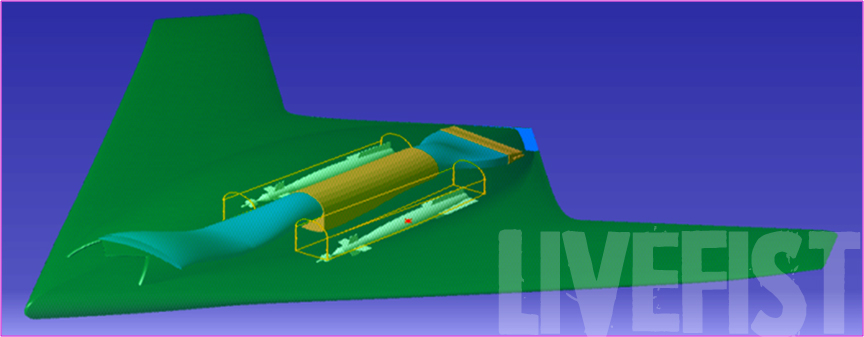
The eagerness not to trumpet the program is understandable. The tussle between the DRDO and services is gratingly familiar too, and explains the DRDO chief’s anxiousness to freeze configurations on the Ghatak as quickly as possible. The DRDO’s LCA Tejas fighter has turned something of a corner and entered service with the Indian Air Force in 2016. But in its wake lies a painful litany of pitfalls that the DRDO is hoping to bridge.
The Ghatak effort is also the first independent effort by India to build an unmanned combat air platform. The headwinds such a project faces are singularly onerous. Quite apart from the fundamental stealth technologies that are being developed literally from scratch are the ambitious timelines the DRDO has set for itself despite a cautious approach to the Ghatak. The proof of the Ghatak will be in whether it is truly the low-observable aircraft it is intended to be, rather than just an interestingly shaped platform. Finally, the electronic wizardry that will bring together the the sensor-weapon loop to give the Ghatak its intended teeth is a steep climb. For one thing, the cautiousness at DRDO is underscored by an ironic abundance of confidence.
“One this is certain. We have to build and prove the Ghatak. It is the future. We have started well. And we will get there. Failure is not an option,” Dr. Christopher says.
India needs manned combat aircraft. Lots of them, and quickly. It’s the refrain you’ll unfailingly hear from military planners every year. As things stand, every single one of those requirements will be met by imported jets either built abroad, or manufactured under license in India. From single engine fighters for the Indian Air Force to twin engine carrier borne fighters for the Indian Navy to fifth generation fighter aircraft. It’s a busy, familiarly turbulent matrix of intrigue that continues to dog India’s quest for an elusive air power equilibrium. A turbulence buffeted by the pressures of budget, costing and, at the higher end, by the very paradigm of manned combat flight.
But if there’s some relief from this bustle, then the tiniest escape hatch into the future is nestled many hundreds of kilometers away from the power centers of Delhi — the outskirts of the dusty industrial hub of Kanpur, and the verdant suburbs of Bengaluru and Hyderabad, where a group of students, professors and the country’s top aerospace scientists are steeped in the sort of research that will — ultimately and hopefully — launch India into a new paradigm of air combat capability.
NOTE: Since the subject matter of this post pertains to a classified Indian project, the information and data have been vetted by Livefist through our government sources before posting.

“The project is fully positioned as a futurustic platform.” An inadvertent pun perhaps??
FUTU – RUSTIC? or Prophetic?
Jokes aside I do hope this project makes it! Boy, do we need it!
Uday
Great article shiv. Great effort from your side.
Even small drones would be useful for the country. Bigger drones should be hack proof and secure and can be used for strategic bombing. Hopefully they will also develop smaller the SWiFT too for both surveillance and targeting with a few air to surface missiles/bombs etc. Certainly be celebrating if we hear it fly.
u people had revelead and most of pakistan and china usa might be watching this carefully 😀
Dear sir,
Despite it being vetted by government agencies, I would like to express my concerns about the risks of sharing images of the airframe. As I have been a student of aerodynamics and performed computer simulations, I know its very easy to reverse engineering an airframe based on images from 3 views. Using the latest software tools, a soft copy of this airframe can be generated and if needed, it can reveal some flight capabilities to the enemy camp. Kindly be careful before showing such images.
Why is such supposedly secretive projects being discussed in a open forum open to all including our enemies? How difficult is it for Pakistan or China to infiltrate/hack into the IIT Kanpur systems. I am sure the security apparatus of IIT Kanpur is incapable to ward off such a state sponsored attack if it were to happen. Given the importance of such projects its in the best interest of the country to not report such matters and the responsibility lies on the reporter to use some common sense. I understand the pressure to come out with breaking news articles, but come on its not all about you. Maturity and responsibility in Indian journalism is the need of the hour. Also shame to all the officials who have made comments out of their turn. The hard work you may have put in so far may just vanish in a swift cyber attack. Everyone concerned, please learn to be humble and use your common sense for the country’s sake. You are doing the greatest disservice by giving out such details.
Nationalism comes before journalism. Stop, think and be mature before you write such articles which could do more harm than benefit any reader. Understood you want more visitors, etc but be a bit smart about what you should and shouldn’t write.
Why are idiots like Dr S. Christopher giving exclusive interviews about classified indian defence projects so openly ?? Do the sources have requisite clearances to speak about these projects? If not they should be sued under the Official Secrets Act for disclosing national secrets.
Typical boast by DRDO. They are trying to run a marathon without crawling! First, rectify Tejas /LCA so that its a proper fighter aircraft, with MAWS & self-protection jammer and an aircraft that is not only pilot-friendly but maintenance-friendly. When is the FOC of Tejas?
Next, no progress on Tejas Mark1A and they want to jump to Ghatak by 2020.
I doubt whether DRDO will supply 20 Tejas ordered by IAF by 2020 in FOC configuartion!
These are all academic programs, wasting our tax-payer hard-earned money! Sack the lot and save money of their salaries and other expenditure to fund Indian armed forces.
DRDO and ADA should keep quite and work hard on delivering. Not just half baked cakes but a full bodied chicken tikka masala and soft naans. Until the time that the curry is ready they should not utter a word about the secret recipes to themselves.
Where are the next parts shiv?
There is no qsr for this.
Now you can make comic
Grow up and stop reporting indias top secret programs. Its called mature journalism
something your pea brain cannot grasp.
As the intent was to make people laugh, the joke could have been smaller.
LCA has no FOC till date
IJT-Sitara has hit a design failure
LCH Helicopter was supposed to get FOC in 2014, today is 2018
Saras, a piddly 14 seater passenger plane is 25 years in the making
Best that can be done is privatize DRDO/HAL/ADA etc and get the work done on a contract basis, otherwise generations will go, but India will keep on making paper planes through SC/ST/OBC armies
Shiv is being entirely responsible by telling us that at least India is also trying to build its own 5Gen. I don’t think that Pakistan/China have the slightest interest in our designs. Moreover, how do we know the designs being shown are not disinformation? US does that a lot, why cant we? Since at this stage we’re just doing models, the real thing may be quite different. As for keeping secrecy, I can assure you from personal knowledge very little of what India does is secret from anyone except the general public. Not being cynical, just stating facts. Anyway, India, good luck. I do agree with critics the whole R&D process and procurement is all messed up.
All this is very interesting. But we do not know how to equip the infantry who waited 13 years to have his first deliveries. The famous tank ARJUN, has a hard time being accepted by the Army etc … We must be realistic realistic. You build a house, not by building your roof. We must start with the foundations and on this side we are very fragile. What a mess for 70 years!
Paradoxical journalism this. Title says Inside view of secret program! If it’s a secret program how can you get inside view and if you get an inside view it’s no more a secret program. No matter what, the program and news doesn’t sound serious enough at all, not especially one which can become a full-fledged full stealth unmanned fighter, which is 6th gen stuff. Hard to imagine, India leapfrogging to 6th gen fighters without even mastering 4th gen Tejas. Plus, if it’s really a secret program, this would have been dealt with in modular approach with each team not knowing what the other team is doing. Only a handpicked few scientists operating in an unexpected location would have all module details.
If we could build an airforce with only wind tunnel models we would have become a super power now.
Thanks for sharing this information. Really encouraging to know that India is finally on the committed path to build a state of the art UCAV. Glad that it will mostly be an indigenous program.
To all those that are complaining about sharing details that can expose it to the enemy, please take a chill pill. There are a couple of these designs from different countries and in production. If it was that easy to copy then every Tom and Dick country will be designing one.
I don’t understand why such news is published. If it’s true, do it quietly and quickly.
It should be “programme” (a set of activities), not “program” (software program), and “metres” (unit of measurement), not “meters” (measuring devices).
End of the day we will import these flying beasts from US or USSR.